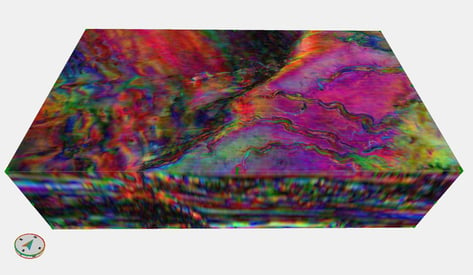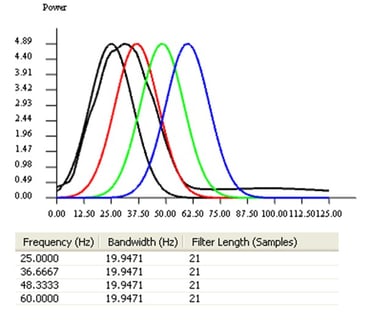The Standard Frequency Decomposition module uses bandpass filters to carry out decomposition with properties similar to either a Fast Fourier Transform (FFT) or to a Constant Wavelet Transform (CWT). Due to the nature of the waveform transformation between the frequency and time domains there is resulting uncertainty, as defined by uncertainty principle. Therefore, the different frequency decomposition methods show differences between the frequency resolution and temporal resolution with the two being traded off against each other.
Over the next three editions will focus on the different frequency decomposition techniques available in Geoteric. In Part 1 we will look at the Constant Bandwidth decomposition method.
Part 1 – Constant Bandwidth
The Constant Bandwidth method utilises bandpass filters to carry out decomposition with properties similar to a Short Window Fourier Transform (FFT). It is a good reconnaissance option since it provides excellent frequency resolution and is fast to process; however, it tends to lack the vertical resolution of other available techniques required for detailed reservoir scale analysis. Constant Bandwidth mode is generally used when the aim of the decomposition is to differentiate between different geological elements on the basis of their bulk properties, for example delineation of large channel systems, salt bodies or gas chimneys.

When using the Constant Bandwidth method the bandwidths and filter lengths of the individual frequency bands are the same, which allows a like-for-like comparison between the bands. The filter lengths are generally high and therefore there is a large amount of vertical smearing, however due to the relatively narrow bandwidths high frequency resolution can be achieved.
 The filter length is controlled by the minimum frequency set; a low minimum frequency will require a longer filter length to sample, if this is increased a smaller filter length can be achieved. The bandwidth scale can also impact the filter length – a narrower bandwidth will require a larger filter length and vice-versa.
The filter length is controlled by the minimum frequency set; a low minimum frequency will require a longer filter length to sample, if this is increased a smaller filter length can be achieved. The bandwidth scale can also impact the filter length – a narrower bandwidth will require a larger filter length and vice-versa.
